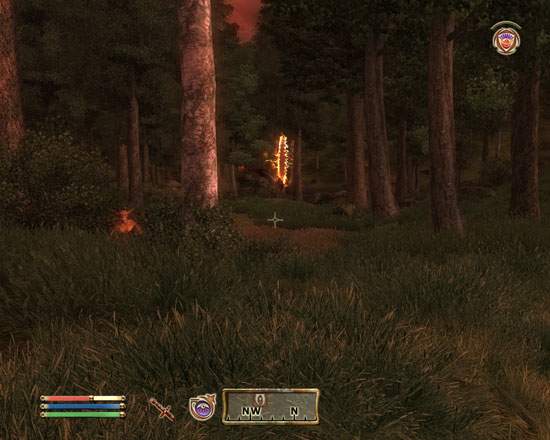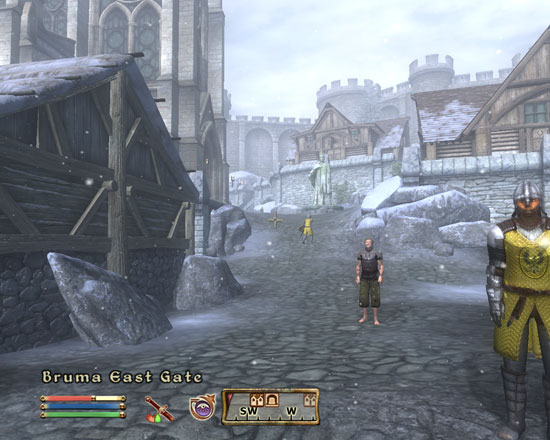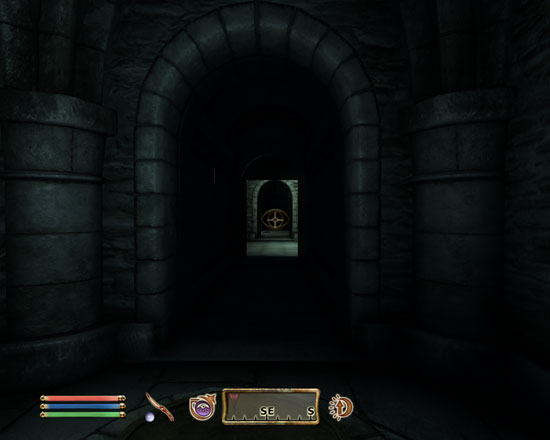The Elder Scrolls IV: Oblivion GPU Performance
by Anand Lal Shimpi on April 26, 2006 1:07 PM EST- Posted in
- GPUs
When both Doom 3 and Half Life 2 came out we burned the midnight oil trying to put together guides for CPU and GPU performance in the games as soon as they were released. Much to our surprise, especially given the performance hype that had preceeded both of them, both games ran relatively well on most mainstream hardware that was available at the time. One GPU generation later and the worries about performance under Doom 3 and Half Life 2 were yesterday's news. The same, unfortunately, cannot be said about Bethesda Softworks' latest immersive RPG: Oblivion.
The game itself is more addicting and immersive than any of its predecessors and its reviews confirm that. But we're not here to tell you that the game is great, we're here to tell you what you need to run it. The fact of the matter is that Oblivion is the most stressful game we've ever encountered, taking the crown away from F.E.A.R. as something that simply doesn't run well on anything. Obtaining good performance under Oblivion is so hard that a number of optimization guides have popped up helping users do whatever it takes to make the game playable. At AnandTech we've been using the Oblivion Tweak Guide from Tweakguides.com and recommend reading it if you're looking to get a good idea for the impact of the many visual settings available in the game.
Just as we've done in our previous articles on Doom 3 and Half Life 2, we're splitting our Oblivion performance coverage into multiple parts. This first part will focus on high-end and mid-range PCIe GPU performance and future articles will look at CPU performance as well as low-end GPU and AGP platform performance if there is enough demand for the latter two. Where we take this series of articles in the future will depend on many of your demands and requests, so please make them heard.
Benchmarking Oblivion
There are really three types of areas you encounter while playing Oblivion, you'll find your character either: 1) Outdoors, 2) Inside a town but still outdoors, or 3) Inside a building or dungeon. Interestingly enough, our seemingly haphazard list of Oblivion locales is actually organized in ascending order of performance. You'll encounter your absolute highest performance inside buildings while you'll actually contemplate spending $1200 on graphics cards whenever you find yourself outside. It only made sense that we benchmarked in each of those three areas, so we constructed manually scripted (read: walk-throughs by hand) benchmarks taking us through one of each type of area in Oblivion.

Oblivion Gate Benchmark
The first test is our Oblivion Gate benchmark, which just so happens to be the most stressful out of all three. In this test we've spotted an Oblivion gate in The Great Forest and walk towards it as scamps attempt to attack our character. The benchmark takes place in a heavily wooded area with lots of grass; combined with the oblivion gate itself, even the fastest GPUs will have trouble breaking 30 fps here.

Town Benchmark
The next test takes place in the town of Bruma and simply features our character walking through a portion of the town. There are a few other characters on screen but no major interaction takes place. Despite the simplicity of the test, since it takes place outside the frame rate is already quite stressful on some mid-range GPUs.

Dungeon Benchmark
Our final test takes place in the Sanctum on our way to the Imperial City prisons; this "Dungeon" benchmark showcases indoor area performance and consists of our character sneaking through the dimly lit Sanctum. There are guards around however none appear in the view of our character. Many cards will do well in this test, but unless they can pass the first benchmark their performance here is meaningless.
We measured frame rates using FRAPS and reported both the minimum and average frame rates in our charts (we left out maximum frame rates because they simply aren't as important and they made the graphs a little too difficult to read when we included them). The minimum frame rates are indicated by a vertical white line inside the bar representing average frame rate.
Since we measured performance using FRAPS and not through a scripted timedemo sequence, the amount of variance between runs is higher than normal; differences in performance of 5% or less aren't significant and shouldn't be treated as such.










100 Comments
View All Comments
cgrecu77 - Wednesday, April 26, 2006 - link
consoles are not great and they're a waste of money - think about Oblivion, the game barely runs on 6 months box (Xbox360). Do you honestly think that in 5 years a top of the line PC game will run on an XBox? I bought my x850XT last year for less than $300 on eBay and I can play this game at my lcd's native resolution (1280x1024). I'm pretty sure that with my current video card I'll be able to play games for 1 year or so and then I can probably buy the X1900XT for ~300 and that will give me another 2 years.Lower the resolution a little and you can extend it even further.
The biggest danger is to avoid buying middle range/ extrem upper range - this way you'd be screwed. If I would've bought a 6600GT last year it would've been a bad decision. If I'd buy a x1800GTO now it would be a poor decision also, because it can barely play the new games, in one year it'll become obsolete. The trick is to buy things that last 2 years at a decent price.
The problem with consoles are that if you buy beyond the first year or two you are actually buying an obsolete piece of hardware (think about the original Xbox, still selling - it's p3 with geforce 2 or 3). In the past consoles had a big advantage by running at low res, but once hdtv becomes mainstream they would have to support pc resolutions. If you have an hdtv you know that low-res content looks like crap with or without upconverting to a higher res (take a picture at 400x300 and enlarge it with Photoshop to 1600x1200 and you'll see what I'm talking about).
pnyffeler - Wednesday, April 26, 2006 - link
Is there any way anyone can look at these numbers and not just by an Xbox360? I had a feeling my 6800GT wouldn't cut it, but wow! It's games like this that make the feasibility of upgrading your PC to play the latest game ridiculously stupid. Spend the $470 to get the console and the game.If you really feel the need to spend more money than that, I'd recommend investing in a nice HDTV. Oblivion in hi-def from your couch is about as good as it gets.
Now if I could just get the Mrs. to stop hogging the TV...
mesyn191 - Wednesday, April 26, 2006 - link
In every bench instance shown they're testing at a higher resolution than the X360 will ever display...Also the X360 version only looks good if you've got the HDTV to go with it, otherwise it really does look like crap on a SDTV.
Gameplay wise this game is very very good, not perfect, but better than any other game I've played.
erwos - Thursday, April 27, 2006 - link
That's flatly untrue. The X360 has a 1280x1024 resolution with the VGA adapter. Also, the PC version would also look like crap on an SDTV, so that's not really a valid point against the 360.-Erwos
mesyn191 - Thursday, April 27, 2006 - link
That is the X360's built in video scalar doing the work though, max that any game renders real time ATM on the X360 is 720p due to the limited amount of EDRAM available. Real and not scaled 1080i may be possible, but only if the developer specifically designs the game for it by cutting out effects, reducing textures, etc. and does not use FSAA.http://www.beyond3d.com/articles/xenos/">http://www.beyond3d.com/articles/xenos/
My point about how the X360 games look on a SDTV is valid as most people don't use thier PC's with a SDTV or any TV at all, they use a CRT or LCD monitor... The opposite is almost never true in the X360's case.
hondaman - Wednesday, April 26, 2006 - link
I would have upgraded my "crappy" 7800gtx had I known how bad my FPS really is.I love this game. Easily the best game I've ever played in my life. Its not perfect, and I wont defend it as being so, but overall, its magnificent. I have over 270 game hours, and still havent done everything there is to do.
mpeavid - Wednesday, April 26, 2006 - link
The engine is extremely inefficient. The quests are not really that interesting.The NPCs are stiffs.
Overall? 8/10.
The game engine needs major tweaking.
FYI - eliminate the grass totally and you can increase your frame count by as much as 50%. There is also a tweak to increase threads (another possible 50% increase).
I went from 20 fps outdoors to near 30 fps with higher visual settings (except the grass part)
Spoonbender - Wednesday, April 26, 2006 - link
You know, it seems they've compiled the game in debug mode... :)That's how much they've bothered tweaking performance. ;)
When the game crashes (which happens to be every time I exit the game, or alt-tab too much), I get an access violation, always on special debug locations, like 0xCDCDCDCD or 0xFEEEFEEE.
So, yay for high performance tweaking.
JarredWalton - Wednesday, April 26, 2006 - link
Lowering grass height and detail is probably the best tweak you can make. I set mine for "60" in terms of density and half as tall (I think?) and performance went WAY up without seriously ruining (IMO) the appearance.As for the game, it depends on what you're after. I really like the game, but the UI has some major issues. I think the quests are relatively well done overall. I love the huge game world (huge in content, not in square miles). Eventually, though, a lot of the game becomes repetitive. I've been doing too many side quests; time to hit the main quest in earnest.... :)
kmmatney - Wednesday, April 26, 2006 - link
I installed a mod for the UI (BTMod) to make the UI windows larger and its a huge improvment. I dont bother with Bloom, and performance is acceptable on my modded X800GTO2 and Sempron @ 2.4 GHz.